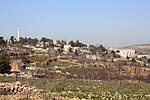Gush Etzion

Gush Etzion (Hebrew: גּוּשׁ עֶצְיוֹן, lit. Etzion Bloc) is a cluster of Israeli settlements located in the Judaean Mountains, directly south of Jerusalem and Bethlehem in the West Bank. The core group includes four Jewish agricultural villages that were founded in 1943–1947, and destroyed by the Arab Legion before the outbreak of the 1948 Arab–Israeli War, in the Kfar Etzion massacre. The area was left outside of Israel with the 1949 armistice lines. These settlements were rebuilt after the 1967 Six-Day War, along with new communities that have expanded the area of the Etzion Bloc. As of 2011, Gush Etzion consisted of 22 settlements with a population of 70,000.The international community considers Israeli settlements in the West Bank illegal under international law, but the Israeli and US governments dispute this.
Excerpt from the Wikipedia article Gush Etzion (License: CC BY-SA 3.0, Authors, Images).Gush Etzion
HaAvot, Beitar Ilit
Geographical coordinates (GPS) Address Nearby Places Show on map
Geographical coordinates (GPS)
| Latitude | Longitude |
|---|---|
| N 31.657778 ° | E 35.120833 ° |
Address
HaAvot
Beitar Ilit
Judea and Samaria, Palestinian Territories
Open on Google Maps








